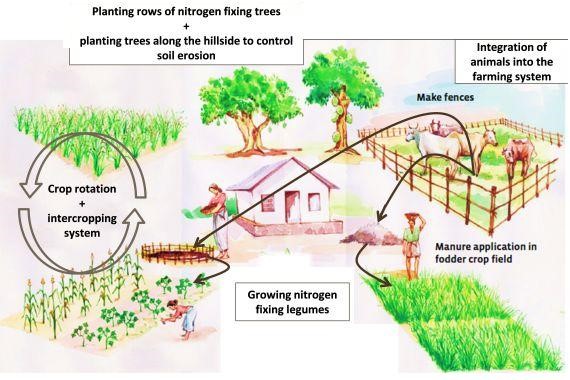Integrated Farming System (IFS): Source of Food and Livelihood Security
Y.S. Jadoun1*, Sarvjeet Kaur1, Rakesh Kumar2 and A. K. Thakur3
Sanjay Gandhi Institute of Dairy Technology (SGIDT), Bihar Animal Sciences University (BASU), Patna-800014
1*, Associate Professor & Head, Department of Dairy Extension Education, SGIDT, BASU, Patna-14
1, Assistant Professor, Department of Dairy Extension Education, SGIDT, BASU, Patna-14
2, Associate Professor & Head, Department of Dairy Microbiology, SGIDT, BASU, Patna-14
3, Director Extension Education, BASU, Patna-14
Corresponding Author Email ID: ysvet1203@gmail.com
Introduction
In the present situation the demand and supply for food has changed due to higher population and the shift of people in the cropping pattern. The per capita availability of land is decreasing day by day because of growing in the population. So, in order to meet out the demand of increasing population to produce more quantity by maintaining the quality of food in limited area. By adopting the integrated farming system which requires lesser space and ensures higher productivity of the system is the only option which left out for us. The practice of cash return farmers will improve the economic condition of the farming community.
Integrated farming system (IFS) represents an appropriate combination of farm enterprises viz. Cropping systems, horticulture, livestock, fishery, poultry, forestry and the means available to the farmers to raise them for profitability. It interacts effectively with environment without dislocating the ecological and socio-economic balance on one hand and attempt to meet the national goal on the other. The farming system in its actual sense will help in different ways to lift the economy of agriculture and standard of living of the farmers of the country as a whole.
Key principles of IFS
Cyclic: The farming system is basically cyclic (organic resources – livestock – land –crops). Therefore, management decisions linked to one component may affect the others.
Rational: Using crop residues more judiciously is an important route out of poverty. For resource-poor farm families, the correct management of crop residues, together with an optimal allocation of scarce resources, leads to sustainable production.
Ecologically Viable: Linking ecological sustainability and economic viability, the integrated livestock-farming system maintains and improves agricultural productivity while also reducing negative environmental impacts.
Objectives of IFS are:
- To identify present farming systems in specific areas and access their relative feasibility.
- To frame farming system model involving main and related enterprises for different farming situations.
- To ensure optimal utilization and safeguarding of available resources and effective recycling of farm residues within system and;
- To maintain viable production system without damaging resources/environment.
- To increase overall productivity of farm household by complementing main allied enterprise with each other.
- To maintain environmental excellence & ecological stability.
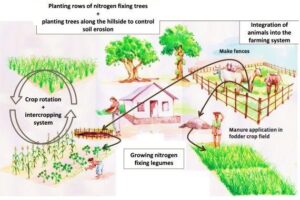
Fig 1. Integrated Farming System Model
Goals of Integrated Farming Systems (IFS):
- Provide a stable and constant income transformation of the system’s productivity
- Achieve agro-ecological stability through the reduction in the build-up of pests and diseases, through natural cropping system management and the reduction in the use of chemicals (inorganic fertilizers and pesticides).
- Maximize return from the unit area
- Maintaining soil status and fertility
- Exploiting the byproduct of one component of the farming system as an input in other
- Reducing environment pollution
- Increasing cost-effective yield per unit area, per unit time, profitability & sustainability
- Provides balanced nutritious food to the farming community & pollution free environment
- Income round the year
- Solve the energy, fodder, fuel & timber crisis
- Rural employment generation
- Improve the socio-economic status (SES) of the farm families.
- Reduced expenditure & increased net profit
Components of Integrated Farming Systems (IFS):
- Crop Husbandry
- Livestock
- Poultry
- Duck farming
- Horticulture/Vegetable Farming
- Aquaculture
- Bee Keeping
- Sericulture
- Mushroom Cultivation
- Agro-forestry
- Bio-gas Plants
- Miscellaneous Enterprises
Types of Integrated Farming System
- Crop-livestock farming system (CLFS)
- Crop-livestock-fish farming system (CLFFS)
- Crop-livestock-poultry-fish farming system (CLPFFS)
- Crop-poultry-fish-mushroom farming system(CPFMFS)
- Crop- fish – poultry farming system(CFPFS)
- Crop-livestock-fish-vermicomposting farming system (CLFVFS)
- Crop-livestock-forestry farming system (CLFFS)
- Agri-silvi-horticulture system (ASHS)
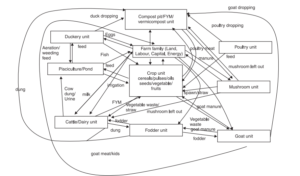
Fig.2 Input-output flow diagram of developed IFS Module (Source: Kumar et al. 2018)
Scope of Farming System
Integrated Farming enterprises include crop, livestock, poultry, fish, horticulture, sericulture etc. A combination of one or more enterprises with cropping system when carefully chosen, planned and executed gives greater dividends than a single enterprise, especially for small and marginal farmers. Farm as a unit is to be considered and deliberate for effective integration of the enterprises to be combined with crop production activity.
Combination of Farm Enterprises Depends on Many Factors Such as:
- Soil and climatic features of the selected area.
- Availability of the resources, land, labor & Capital.
- Present level of utilization of resources.
- Economics of proposed integrated farming system.
- Managerial skill of farmer.
The Characteristics of Integrated Farming System Research
- It is holistic or system oriented,
- It is problems solving: involvement of farmers in problem identification and solving process,
- It is farmer participatory,
- It emphasizes extensive “On Farm” activities.
- It envisages location specific technology solutions,
- It adopts bottom-up approach,
- It recognizes Indigenous Technology Knowledge (ITK)
- It is gender sensitive,
- It ultimate objective is sustainability,
- It focuses on actual adoption,
- It recognizes interdependence among multiple clients.
Advantages of Integrated Farming System
In an integrated system, livestock and crops are produced within a coordinated framework. The by-product of one component serves as a resource for the other. For instance, manure is recycled to improve crop production; crop residues and by-products feed the animals, supplementing often inadequate feed supplies, thus contributing to improved animal nutrition and productivity.
The result of this cyclical combination is the mixed farming system, which exists in many forms and represents the largest category of livestock systems in the world in terms of animal numbers, production and the number of people linked with it. Animals play key and manifold roles in the functioning of the farm, and not only because they provide livestock products (meat, milk, eggs, wool, and hides) or can be converted into prompt cash in times of need.
Animals transmute plant energy into useful work: animal power is used for ploughing, transport and in activities such as milling, logging, road construction, marketing, and water lifting for irrigation. Animals also provide manure and other types of animal waste. Excreta have two vital roles in the overall sustainability of the system.
The advantages of IFS include pooling and sharing of resources/inputs, efficient use of family labour, conservation, preservation and utilization of farm biomass including nonconventional feed and fodder resources, effective use of manure/animal waste, regulation of soil fertility and health, income and employment generation for many people and increase economic resources. It improves space utilization and provides diversified products. The IFS is part of the strategy to safeguard sustainable use of the natural resources for the benefit of present and future generations.
Productivity: IFS offers an opportunity to increase economic yield per unit area per unit time by virtue of escalation of crop and allied enterprises.
Profitability: Use byproduct of one component at the least cost. Therefore decrease in the cost of production and form the linkage of utilization of waste material and elimination of middleman interference in most inputs used. Working out net profit/ BC ratio is increased.
Sustainability: Organic supplementation through actual utilization of byproducts of allied component is done thus providing an opportunity to sustain the potentiality of production base for much longer periods.
Provide Balanced Food: Components of varied nature are linked to produce different sources of nutrition.
Environmental Friendly: In IFS waste materials are effectively recycled by linking appropriate components, thus minimize environment pollution.
Improvement Nutrient Recycling: Effective recycling of waste material (crop residues and livestock wastes) in IFS. Therefore, there is less reliance to external inputs – fertilizers, agrochemicals, feeds, energy, etc. & also contains several nutrients (including nitrogen, phosphorus and potassium) and organic matter, which are important for maintaining soil structure and fertility. Through its use, production is augmented while the risk of soil degradation is reduced.
Income throughout the year: Due to collaboration of enterprises with crops, eggs, milk, mushroom, honey, cocoons silkworm, it provides flow of money to the farmer round the year. There is higher net return to land and labour resources of the farm families.
Adoption of Innovative Technologies: Large farmers fully utilize technology. IFS farmers, linkages the dairy / mushroom / sericulture / vegetable. Money flow whole year gives an inducement to the small/ original farmers to go for the adoption technologies.
Providing & saving energy: Excreta is the basis for the production of biogas and energy for household use (e.g. cooking, lighting) or for rural industries (e.g. powering mills and water pumps). Fuel in the form of biogas or dung cakes can replace charcoal and wood & identify an alternative source to reduce our dependence on fossil energy source within short time. Actual recycling technique the organic wastes available in the system can be exploited to generate biogas. Energy crunch can be postponed to the later period.
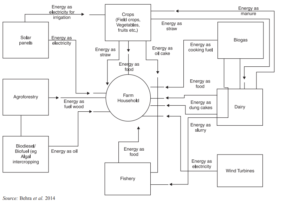
Fig 3. Energy flow among different components of the energy (E)-IFS Module
Meeting Fodder crunch: Every piece of land area is well utilized. Plantation of perennial legume fodder trees on field boundaries and also fixing the atmospheric nitrogen. These practices will greatly solve the problem of non – availability of quality fodder to the animal component linked.
Resolving Fuel and Timber Crisis: Linking agro- forestry properly the production level of fuel and industrial wood can be enhanced without determining effect on crop. This will also significantly reduce deforestation, conserving our natural ecosystem.
Creation of Employment Opportunities: Combing crop with livestock enterprises would increase the labour requirement significantly and would help in reducing the glitches of under employment to a great extent. IFS provide adequate scope to employ family labour round the year.
Agro – industries: When one of produce linked in IFS are increased to profitable level there is surplus value adoption leading to development of allied agro – industries.
Increasing Input Effectiveness: IFS provide good scope to use inputs in different component with greater efficiency and benefit cost ratio.
The overall benefits of crop-livestock integration can be summarized as follows:
- Agronomic, through the retrieval and maintenance of the soil productive capacity;
- Economic, through product divergence and higher yields and quality at less cost;
- Ecological, through the decrease in crop pests (less pesticide use and better soil erosion control)
- Social, through the reduction of rural urban migration and the creation of new job opportunities in rural areas.
- It helps improve and conserve the productive capacities of soils, with physical, chemical and biological soil recuperation. Animals play an important role in harvesting and relocating nutrients, significantly improving soil fertility and crop yields.
- It is rapid, efficient and economically sustainable because grain crops can be produced in four to six months, and pasture formation after cropping is rapid and inexpensive.
- It helps increase profits by reducing production costs. Poor farmers can access fertilizer use from livestock operations, especially when rising petroleum prices make chemical fertilizers unaffordable.
- It results in greater soil water storage capacity, mainly because of biological aeration and the upsurge in the level of organic matter.
- It provides varied income sources, guaranteeing a buffer against trade, price and climate fluctuations.
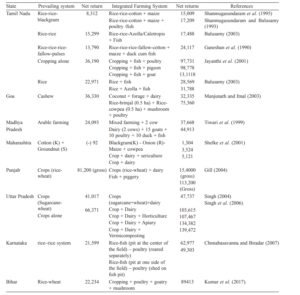
Table1. Economic Viability of Integrated Farming System Research models developed in different states of the Country
Source: Kumar et al. 2018
Some lessons learned and recommendations:
- The maintenance of an integrated crop-livestock system is dependent on the accessibility of adequate nutrients to sustain animals and plants and to maintain soil fertility.
- Animal manure alone cannot encounter crop requirements, even if it does contain the kind of nutrients needed. This is because of its comparatively low nutrient density and the limited quantity available to small-scale farmers. Alternative sources for the nutrients need to be found.
- Growing fodder legumes and using them as an add-on to crop residue is the most practical and cost-effective method for improving the nutritional value of crop residues. This amalgamation is also effective in reducing weight loss in animals, particularly during dry periods;
- Given their indigenous knowledge and experience, local farmers are perfectly able to apply an integrated system. In routine practice, however, relatively few adopt this system, mainly because they have limited access to credit, technology and knowledge. The crop-pasture rotation system is complex and needs a substantial capital outlay for machinery and implements.
- Associations of grain and livestock producers are useful for filling these slits and can promote the adoption of a crop-livestock system;
- Veterinary services are normally unable to reach poor small farmers in remote areas. Therefore, for livestock production to be improved; more attention needs to be paid to making veterinary care accessible, particularly in terms of prevention;
- Better livestock management is needed to safeguard water. Livestock water demand includes water for drinking and for feed production and processing. Livestock also have an impact on water, contaminating it with manure and urine. All of these aspects need to be given due consideration.
- Intensification of agriculture through suitable incorporation of small livestock has the potential to decrease the land needed for agricultural production and relieve the pressure on forests.
The further thrust of IFS is: There is a necessity to create the database on farming system in relation to type of integrated crop-livestock farming system, set-up, economics, sustainability etc. under different farming condition.
- Developing research modules of farming system is necessary under different holding size with varying economically viable and socially acceptable systems.
- The assessment and refinement of the technologies developed at research station at farmer’s field.
- Need to prepare a contingent planning to counteract the climatic threats under diverse farming situation.
- Need to prepare a policy draft for the consideration of planners for its promotion at large scale with nominal financial assistance either through short/ medium/ long term credit facilities.
Conclusion
Integrated farming system seems to be the answer to the glitches of increasing food production, for increasing income and for improving nutrition of the small-scale farm families with limited resources without any antagonistic effect on environment and agro-ecosystem. The IFS provides a progress of money to the farmer round the year by way of disposal of milk, meat, eggs, edible mushroom, honey, silkworm cocoons, etc. This will help a resource-poor farmer to get out of the clutches of moneylenders/agencies. Recycling of organic wastes reduces the requirement of chemical fertilizer. Further, biogas production can meet the household energy requirement. Thus, IFS goes a long way in solving energy crises.
INTEGRATED FARMING SYSTEM FOR SUSTAINABILITY & STABILITY IN AGROVET FARMING


